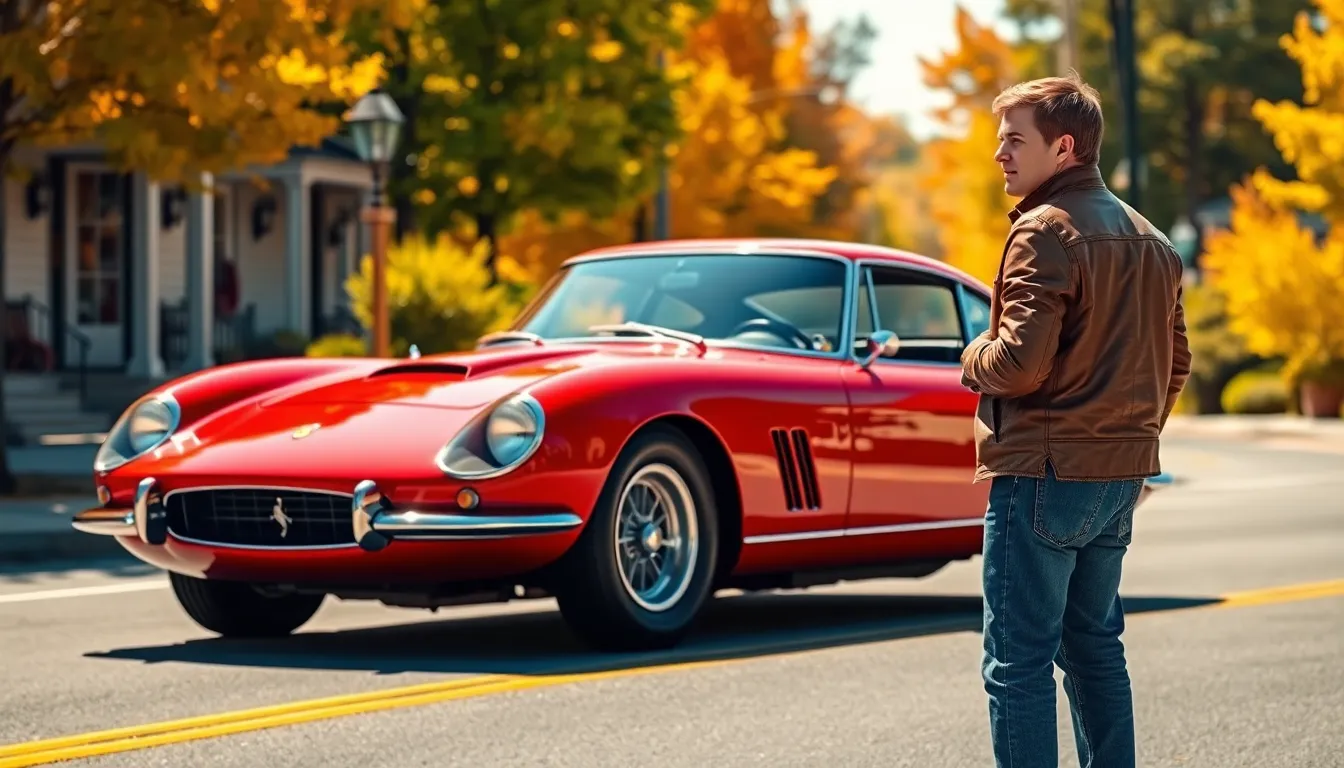The roar of a perfectly tuned engine. The gleam of chrome against sleek curves. The rush of pure adrenaline as you grip the steering wheel of automotive perfection. Classic sports cars aren’t just vehicles – they’re rolling pieces of art that capture the golden age of automotive engineering and design.
We’ve all dreamed of owning one of these legendary machines that dominated racetracks and highways from the 1950s through the 1980s. From the iconic Ferrari 250 GTO to the thunderous Shelby Cobra, these cars represent more than transportation. They’re investments in history, passion projects that appreciate in value, and the ultimate expression of driving pleasure.
Whether you’re a seasoned collector or someone who’s just beginning to appreciate automotive excellence, understanding the industry of classic sports cars opens doors to an exclusive community of enthusiasts. Let’s explore what makes these timeless machines so irresistible and why they continue to captivate drivers decades after they first hit the road.
Define Classic Sports Cars and Their Timeless Appeal
Classic sports cars represent automotive excellence frozen in time, combining performance heritage with design artistry that continues to captivate enthusiasts decades after production. We explore the defining elements that transform ordinary vehicles into legendary classics.
What Makes a Sports Car “Classic”
Age serves as the fundamental qualifier, with most classic sports cars spanning from the 1920s through the early 1990s. We typically consider vehicles over 20-25 years old as classics, though true iconic status often requires 30+ years of automotive history.
Limited production numbers significantly enhance classic status, creating scarcity that drives desirability. Models like the Ferrari 250 GTO produced only 39 units, while the Shelby Daytona Coupe saw just 6 examples leave the factory.
Historical significance elevates sports cars beyond mere transportation into cultural artifacts. We recognize classics through their racing pedigree, technological innovations, or cultural impact during their era.
Design excellence transcends time periods, featuring proportions and styling that remain visually striking today. Classic sports cars showcase clean lines, purposeful aerodynamics, and aesthetic harmony between form and function.
Key Characteristics of Iconic Classic Sports Cars
Performance capabilities defined classic sports cars through superior power-to-weight ratios and handling dynamics. We find these vehicles typically featured lightweight construction, powerful engines, and sport-tuned suspension systems that delivered exceptional driving experiences.
Manual transmissions connected drivers directly to the mechanical experience, offering precise gear changes and complete control over power delivery. Classic sports cars prioritized driver engagement over convenience, creating an intimate bond between human and machine.
| Characteristic | Classic Example | Modern Comparison |
|---|---|---|
| Engine Type | Naturally Aspirated | Turbocharged/Hybrid |
| Transmission | Manual (4-6 speed) | Automatic/CVT |
| Weight | 2,200-3,000 lbs | 3,500-4,200 lbs |
| Driver Aids | Minimal/None | Electronic Systems |
Minimalist interiors focused on essential controls and premium materials like leather and wood trim. We appreciate how classic sports cars eliminated unnecessary features, concentrating resources on driving dynamics and craftsmanship quality.
Open-top configurations or removable roof panels enhanced the sensory driving experience. Convertibles and targa tops allowed drivers to connect with their environment through wind, sound, and weather elements.
Racing heritage legitimized classic sports cars through competition success and technological transfer from track to street. We recognize models that achieved victory at Le Mans, Monaco, or other prestigious racing venues as particularly important classics.
Discover the Golden Era of British Classic Sports Cars
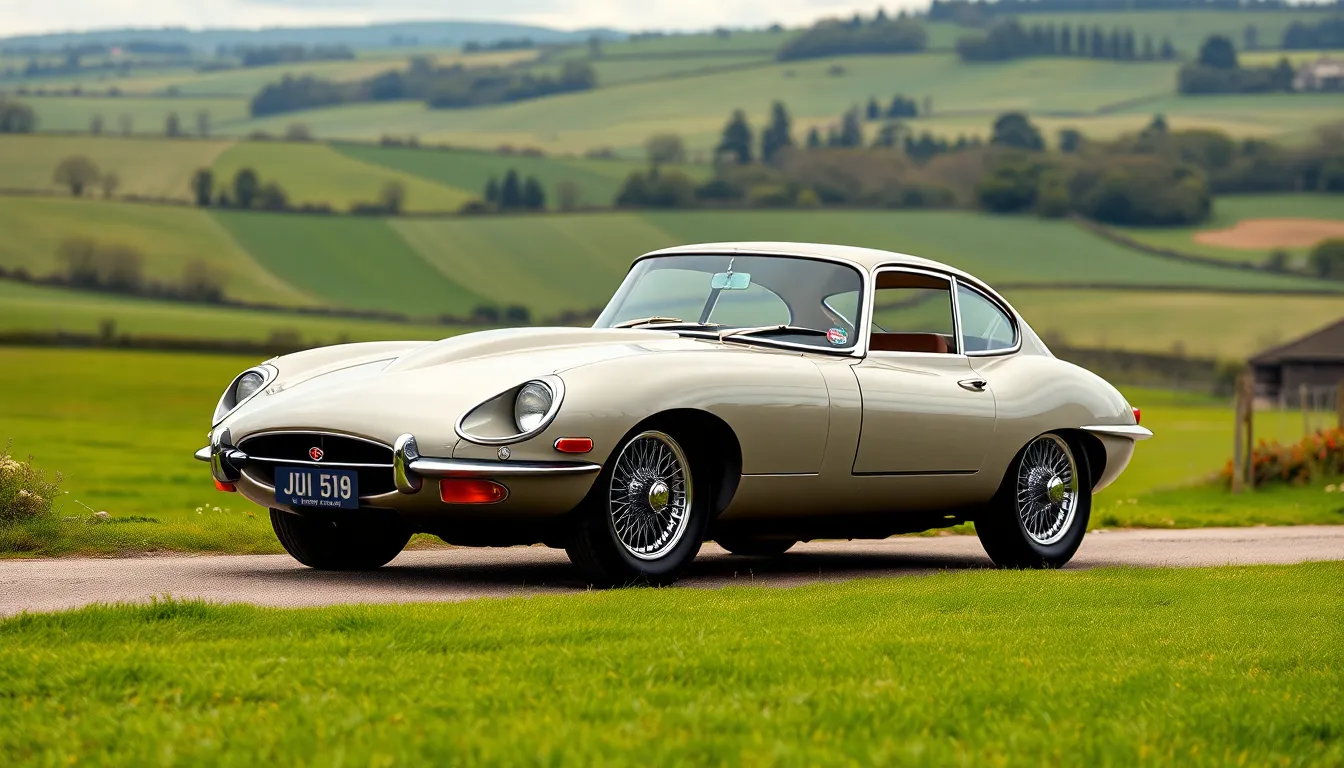
Britain’s automotive industry produced some of the most captivating and influential sports cars during the 1950s and 1960s. These magnificent machines combined elegant design with thrilling performance, establishing British marques as leaders in the global sports car market.
Jaguar E-Type: The Ultimate British Icon
Jaguar E-Type stands as the most celebrated British sports car ever created, earning praise from automotive legends and everyday enthusiasts alike. Enzo Ferrari himself called it “the most beautiful car ever made” when it debuted at the 1961 Geneva Motor Show.
Performance credentials made the E-Type revolutionary for its time. The Series 1 models featured a 3.8-liter inline-six engine producing 265 horsepower, enabling acceleration from 0-60 mph in just 6.9 seconds. Top speeds reached an impressive 150 mph, making it faster than many supercars costing twice as much.
Design elements created an unmistakable silhouette that influenced sports car styling for decades. The long bonnet stretched gracefully over the engine bay while the distinctive oval grille became a Jaguar trademark. Covered headlights provided a sleek appearance, and the fastback roofline on coupe models created perfect proportions from every angle.
Racing heritage enhanced the E-Type’s legendary status through many competition victories. Modified versions dominated tracks worldwide, including wins at prestigious events like the Tour de France Automobile and various endurance races throughout the 1960s.
Aston Martin DB5: James Bond’s Legendary Ride
Aston Martin DB5 achieved global fame as James Bond’s preferred transportation, appearing in iconic films like “Goldfinger” and “Thunderball” during the mid-1960s. Sean Connery’s portrayal of 007 behind the wheel transformed this elegant grand tourer into a cultural phenomenon.
Engineering excellence defined the DB5’s impressive capabilities and refinement. The 4.0-liter straight-six engine delivered 282 horsepower through a smooth five-speed ZF gearbox, providing effortless acceleration and a top speed of 145 mph. Advanced features included four-wheel disc brakes, limited-slip differential, and independent front suspension.
Luxury appointments set the DB5 apart from other sports cars of its era. Hand-crafted leather interiors featured Connolly hides, while Wilton wool carpets and polished aluminum accents created an atmosphere of sophistication. Electric windows, reclining seats, and an optional Motorola radio demonstrated Aston Martin’s commitment to comfort and convenience.
Bond gadgets captured public imagination and boosted sales dramatically after the films’ releases. Q’s modifications included an ejector passenger seat, rotating license plates, bulletproof glass, and retractable tire slashers that became legendary among movie fans worldwide.
MG MGA and MGB: Affordable British Roadster Legends
MG MGA and MGB democratized British sports car ownership by offering genuine performance and style at accessible price points throughout the 1950s, 1960s, and 1970s. These models introduced countless drivers to the joys of open-top motoring while maintaining MG’s reputation for reliability and fun.
Production numbers reflected their massive popularity among enthusiasts seeking affordable thrills. The MGA sold over 100,000 units between 1955 and 1962, while the MGB became even more successful with more than 500,000 examples produced during its 18-year production run.
Technical specifications provided excellent balance between performance and economy. The MGA featured a 1.5-liter B-Series engine producing 72 horsepower, while later MGB models offered up to 95 horsepower from an enlarged 1.8-liter unit. Both cars delivered nimble handling through their lightweight construction and well-tuned suspension systems.
Styling evolution showed MG’s commitment to maintaining classic roadster proportions while incorporating modern touches. The MGA introduced sleek, aerodynamic bodywork that departed from earlier square-rigged designs, while the MGB refined these themes with improved interior space and enhanced creature comforts.
Racing success validated these models’ sporting credentials through victories in club racing and international competition. Modified MGAs and MGBs dominated SCCA racing in America, while works-prepared examples achieved class wins at events like the Monte Carlo Rally and Sebring 12 Hours.
Explore America’s Most Coveted Classic Sports Cars
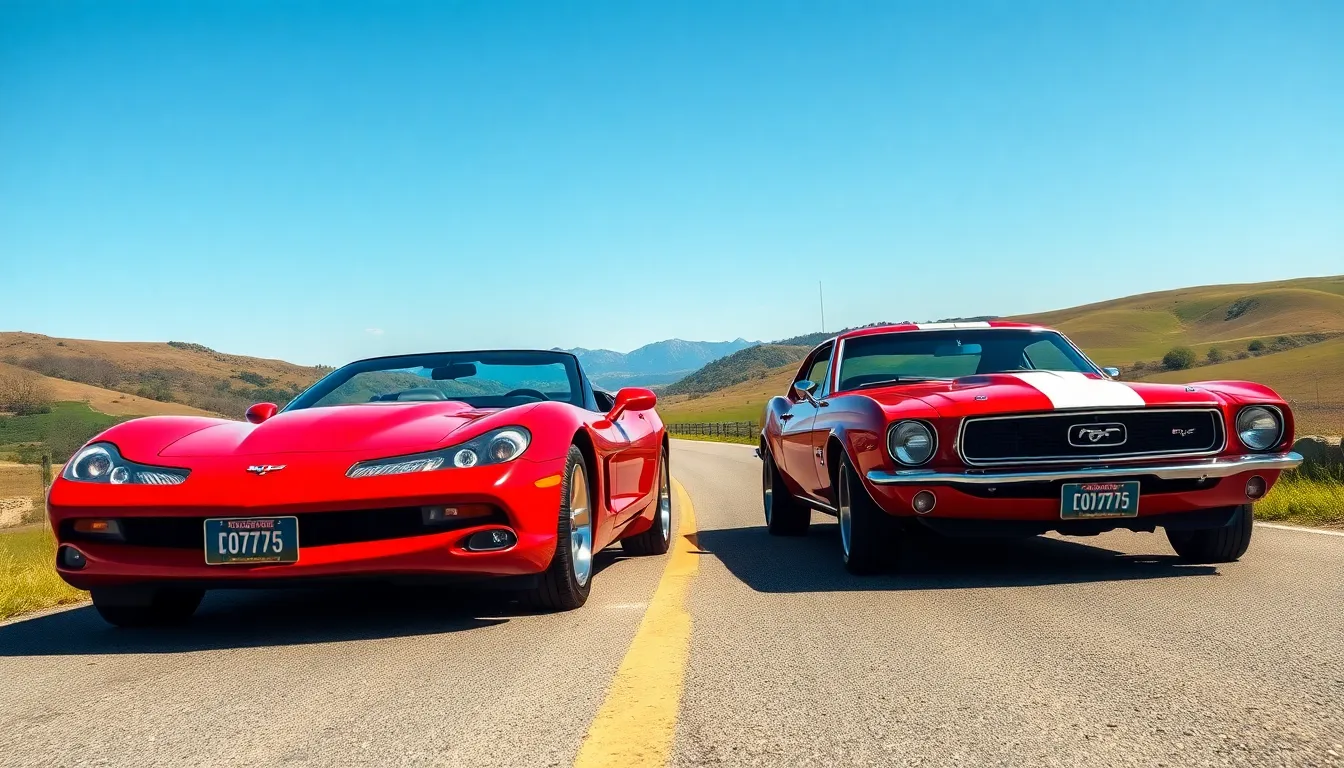
American automotive excellence reaches its peak through legendary sports cars that defined generations of driving enthusiasts. These iconic models represent the pinnacle of domestic performance engineering and cultural significance.
Chevrolet Corvette: America’s Sports Car Legacy
Chevrolet Corvette stands as America’s premier sports car icon since its 1953 debut. We recognize the C1 generation (1953-1962) as the foundation of American sports car excellence, featuring distinctive round taillights and chrome accents that became signature design elements.
Performance milestones define the early Corvette legacy through impressive specifications. The 1957 fuel-injected model produced 283 horsepower from its 283-cubic-inch V8 engine, achieving the coveted “one horsepower per cubic inch” ratio that set industry standards. Racing victories at Le Mans and Sebring during the late 1950s established Corvette’s competition credentials on international circuits.
Design evolution transformed the Corvette from fiberglass novelty to serious performance machine. We observe how the 1963 Split-Window Coupe introduced the iconic Stingray silhouette that remains instantly recognizable today. Production numbers stayed relatively low during these formative years, with only 300 units built in 1953 and peak annual production reaching 14,531 cars in 1969.
Cultural impact extends beyond automotive circles into American popular culture. Television shows, movies, and music videos featured Corvettes as symbols of freedom and performance throughout the 1960s and 1970s. Collector values reflect this heritage, with pristine Split-Window Coupes commanding prices exceeding $150,000 at premium auctions.
Ford Mustang: The Original Pony Car Revolution
Ford Mustang launched in April 1964 as a revolutionary concept that created the pony car segment. We celebrate the first-generation models (1964½-1973) for combining sports car styling with affordable pricing and broad market appeal.
Market reception exceeded all expectations when Ford sold over 400,000 Mustangs in the first year alone. The base model started at $2,368, making performance-oriented design accessible to middle-class buyers who previously couldn’t afford dedicated sports cars. Optional V8 engines ranged from the 260-cubic-inch small block to the legendary 427 Cobra Jet powerplant.
Racing heritage developed through Trans-Am competition and drag racing dominance. Shelby GT350 and GT500 variants transformed the Mustang platform into serious track weapons, with the 1967 GT500 producing 355 horsepower from its 428 Police Interceptor engine. SCCA Trans-Am championships in 1966 and 1967 validated Mustang’s competition capabilities against European rivals.
Design philosophy emphasized long hood, short deck proportions that became the pony car template. We recognize distinctive elements like the tri-bar taillights, side scoops, and aggressive front grille that influenced countless automotive designs. Special editions like the Boss 302 and Mach 1 added performance credibility while maintaining the Mustang’s accessible character.
Cultural significance transformed the Mustang into an American icon featured in films like “Bullitt” and “Gone in 60 Seconds.” Collectible models include the 1965 K-Code Fastback and 1970 Boss 429, with pristine examples commanding premium prices at classic car auctions worldwide.
Shelby Cobra: Raw Power Meets British Engineering
Shelby Cobra represents the ultimate fusion of American V8 power and British sports car handling. We admire Carroll Shelby’s vision of installing Ford 289 and 427 engines into lightweight AC Ace chassis from England, creating one of history’s most celebrated performance machines.
Production numbers remained deliberately limited, with approximately 998 original Cobras built between 1962 and 1967. The 289 Cobra produced 271 horsepower while weighing only 2,315 pounds, resulting in extraordinary power-to-weight ratios that few modern supercars can match. Big block 427 models generated over 425 horsepower, requiring important chassis modifications to handle the increased torque.
Racing achievements include FIA Industry Championships in 1965 and domination of SCCA A-Production racing throughout the 1960s. We observe how Cobras consistently outperformed Ferrari GTOs and Jaguar E-Types in international competition, establishing American credibility in European racing circles. Le Mans victories and Daytona Continental wins proved the Cobra’s versatility across different racing formats.
Engineering excellence combined lightweight construction with sophisticated suspension geometry. The independent rear suspension system provided superior handling compared to solid axle American muscle cars, while the aluminum body panels kept weight to absolute minimums. Racing versions featured even more aggressive aerodynamic modifications and roll cages for enhanced track performance.
Investment potential reflects the Cobra’s legendary status among collectors worldwide. Original 427 models routinely sell for over $1 million at prestigious auctions, while even 289 variants command six-figure prices. Continuation Series replicas built by Shelby American offer authentic driving experiences for enthusiasts seeking Cobra performance without museum-piece pricing.
Uncover Italy’s Legendary Classic Sports Car Heritage
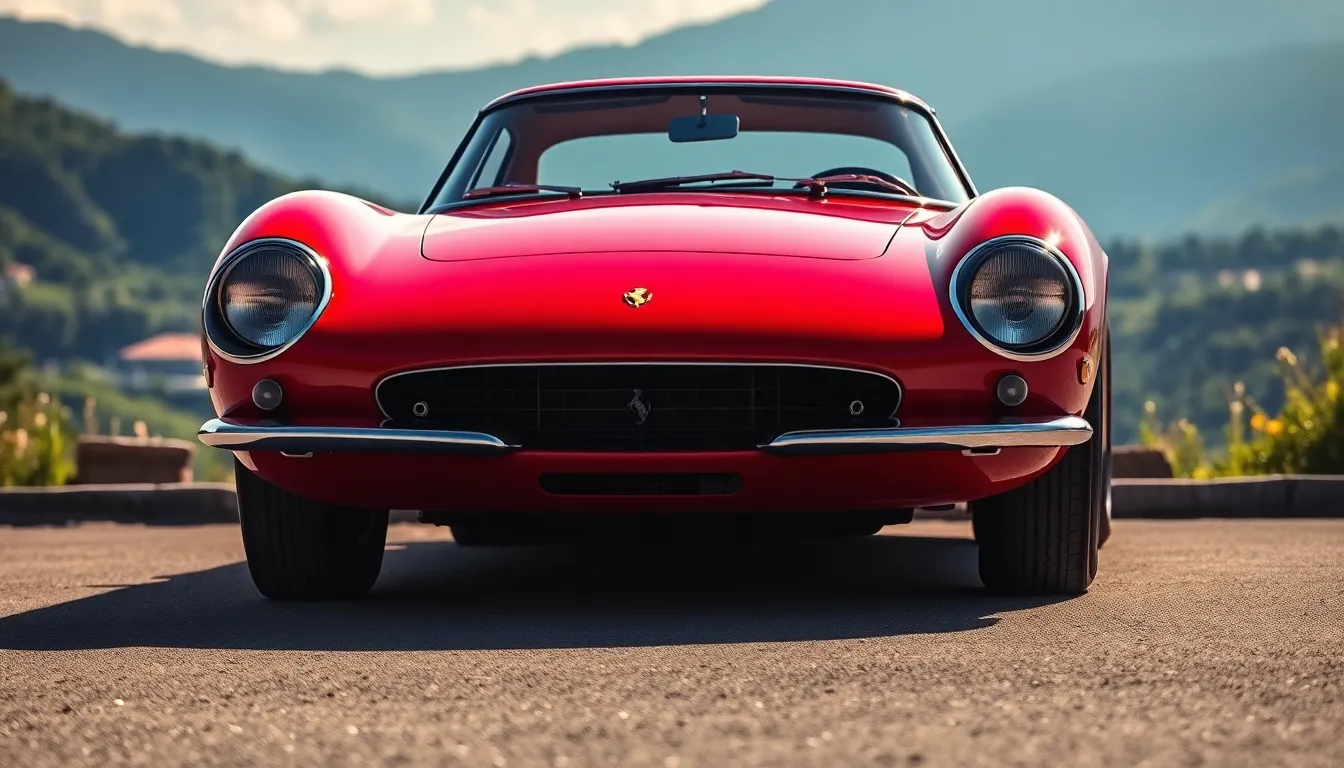
Italy’s automotive legacy represents the pinnacle of passionate engineering and artistic design. We explore three legendary Italian classics that continue to captivate collectors worldwide.
Ferrari 250 GTO: The Holy Grail of Classic Sports Cars
Limited production makes the Ferrari 250 GTO the most coveted classic car on earth. Ferrari manufactured only 36 examples between 1962 and 1964, making each one a priceless automotive artifact. Racing success elevated this model above all others, with victories at Le Mans, Tour de France, and countless international competitions proving its engineering excellence.
Auction prices for the 250 GTO reach astronomical levels that dwarf other classics. Recent sales have topped $48 million, making it the most expensive car ever sold at auction. Design elements like the distinctive long hood, aggressive front air intake, and flowing rear fender lines create timeless beauty that influences modern Ferrari styling.
Performance specifications showcase engineering brilliance from the golden era. The 3.0-liter V12 engine produces 300 horsepower while weighing just 2,120 pounds, delivering exceptional power to weight ratios. Racing heritage includes three consecutive Tour de France victories from 1962 to 1964, cementing its legendary status among collectors.
Lamborghini Miura: The Industry’s First Supercar
Revolutionary mid-engine layout transformed sports car design when Lamborghini introduced the Miura in 1966. Engineers placed the V12 engine behind the driver for optimal weight distribution and handling characteristics. Production numbers totaled 764 units across all variants from 1966 to 1973, making surviving examples highly sought after.
Stunning visual design created automotive sculpture that remains breathtaking decades later. Marcello Gandini’s bodywork for Bertone features flowing curves, pop-up headlights, and dramatic proportions that influenced supercar design for generations. Performance capabilities include 0-60 mph acceleration in 6.7 seconds and a top speed of 171 mph, revolutionary figures for the late 1960s.
Cultural impact extends far beyond automotive circles into popular culture and design history. The Miura appeared in the opening sequence of “The Italian Job” and inspired countless automotive designs. Racing versions competed successfully in European championships, though the model achieved greater fame as a road car than competition vehicle.
Alfa Romeo Spider: Italian Romance on Four Wheels
Affordable elegance defines the Alfa Romeo Spider’s appeal among classic car enthusiasts. Production spanning from 1966 to 1993 created approximately 124,000 examples, making it more accessible than Ferrari or Lamborghini classics. Design by Pininfarina showcases Italian styling excellence with clean lines, perfect proportions, and timeless beauty.
Racing heritage includes victories in touring car championships and rally competitions throughout Europe. The Spider’s lightweight construction and responsive handling made it competitive in various motorsport categories. Engine options ranged from 1.3-liter to 2.0-liter four-cylinder units, providing spirited performance with characteristic Alfa Romeo sound.
Hollywood fame elevated the Spider to icon status through memorable film appearances. “The Graduate” featuring Dustin Hoffman driving a red 1966 Spider created lasting cultural significance. Market values continue rising as collectors appreciate the combination of Italian style, open-air driving pleasure, and relative affordability compared to other European classics.
Navigate Germany’s Engineering Masterpieces in Classic Sports Cars
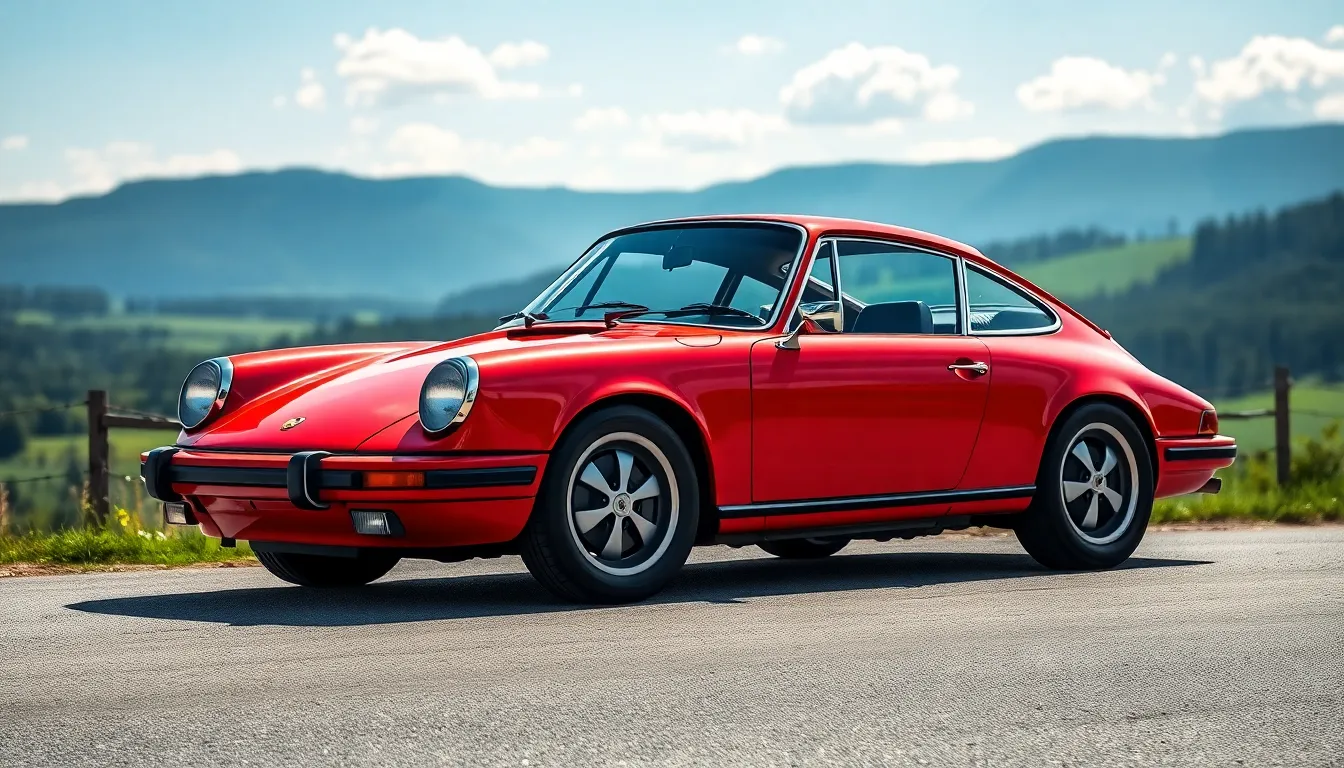
Germany’s precision engineering culture created some of the most innovative and enduring classic sports cars in automotive history. We’ll explore three legendary German models that continue to influence modern automotive design and performance standards.
Porsche 911: The Evolutionary Icon
Porsche’s 911 debuted in 1963 as the 356’s successor and quickly established itself as the definitive German sports car. Ferdinand “Butzi” Porsche designed the iconic silhouette that remains virtually unchanged today, featuring the distinctive sloping roofline and round headlights that became the 911’s signature elements.
Performance capabilities of early 911 models impressed enthusiasts with their rear-engine configuration and exceptional handling characteristics. The original 2.0-liter flat-six engine produced 130 horsepower and delivered remarkable acceleration for its era, while the unique weight distribution provided distinctive driving dynamics that required skill to master.
Racing heritage defines the 911’s legendary status through countless victories at Le Mans, Monte Carlo, and the Targa Florio. Porsche developed specialized racing variants like the 911 Carrera RS 2.7, which featured lightweight construction and aerodynamic enhancements that influenced production models for decades.
Cultural impact extends beyond performance statistics as the 911 became a symbol of German engineering excellence and automotive sophistication. We see its influence in modern sports car design principles, with manufacturers still referencing the 911’s proportions and engineering philosophy in contemporary models.
BMW 2002: The Ultimate Driving Machine Genesis
BMW’s 2002 launched in 1968 as a compact sports sedan that revolutionized the premium performance car segment. This model transformed BMW from a small Bavarian manufacturer into a global luxury performance brand, establishing the foundation for the company’s “Ultimate Driving Machine” philosophy.
Engineering excellence characterized the 2002 through its lightweight construction and perfectly balanced chassis dynamics. The 2.0-liter four-cylinder engine delivered 100 horsepower in standard form, while the turbocharged 2002 Turbo became Europe’s first production turbocharged sedan with 170 horsepower.
Innovation features included BMW’s signature kidney grille design, independent rear suspension, and precise steering that created an captivating driving experience. The 2002’s interior focused on driver-centric controls and high-quality materials that established BMW’s reputation for premium cabin environments.
Market influence of the 2002 created the sport sedan category that continues to dominate luxury car sales today. European and American enthusiasts embraced the model’s combination of practicality and performance, leading to production numbers exceeding 860,000 units across all variants.
Mercedes-Benz 300SL Gullwing: Innovative German Excellence
Mercedes-Benz introduced the 300SL Gullwing in 1954 as the industry’s fastest production car, featuring groundbreaking technology that established new automotive engineering standards. The distinctive upward-opening doors weren’t just styling flourishes but necessary answers to the car’s tubular space frame construction that prevented conventional door placement.
Technical achievements included the first production fuel injection system, which helped the 3.0-liter inline-six engine produce 215 horsepower and achieve a top speed of 163 mph. Advanced aerodynamics and lightweight aluminum body panels contributed to performance capabilities that exceeded contemporary Ferrari and Jaguar models.
Racing pedigree originated from the 300SL race cars that dominated international competition in 1952, winning events like the Carrera Panamericana and Le Mans 24 Hours. Mercedes developed the road-going Gullwing to capitalize on this racing success and demonstrate the brand’s technological capabilities to affluent customers worldwide.
Collectible value of original 300SL Gullwings continues to appreciate, with pristine examples selling for millions of dollars at auction. We recognize the model as a milestone in automotive design and engineering that influenced supercar development for generations, establishing Germany as a leader in high-performance luxury vehicle production.
Understand the Investment Value of Classic Sports Cars
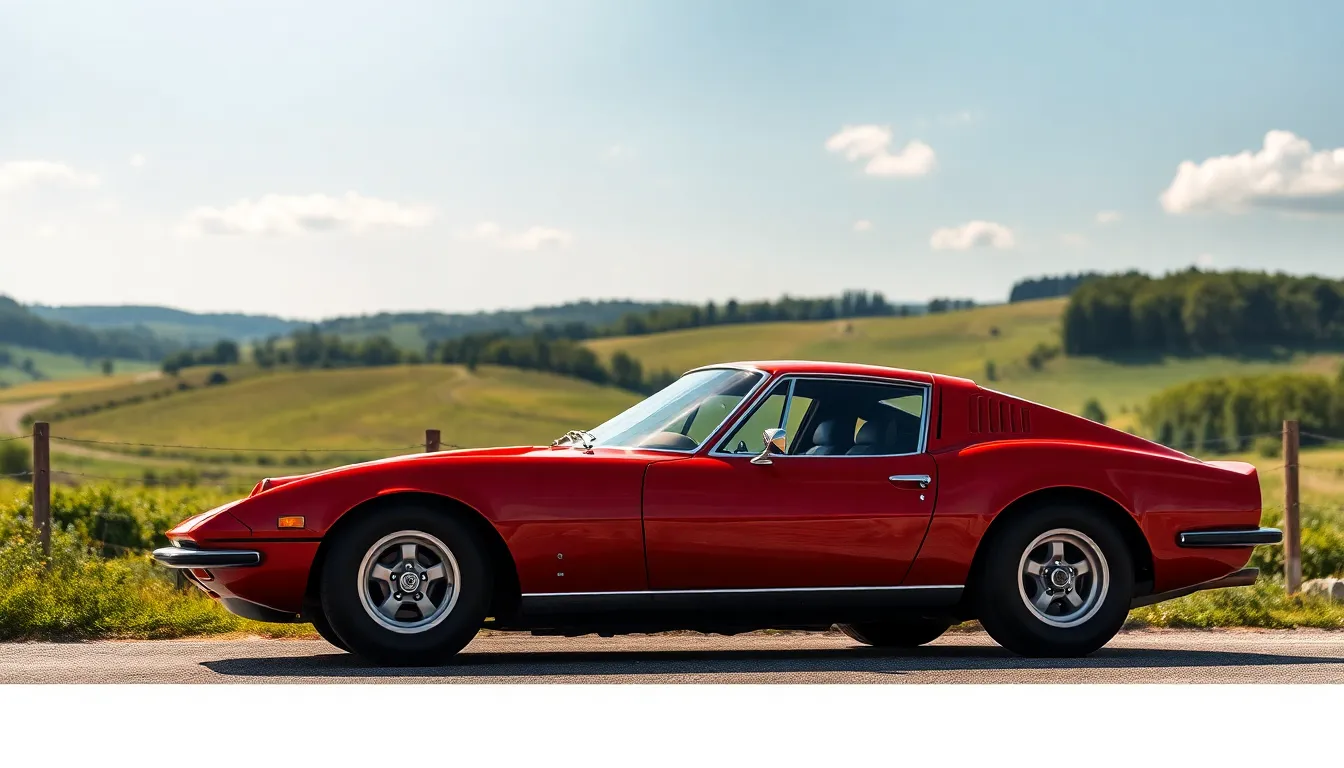
Classic sports cars represent one of the most compelling alternative investment opportunities available today. We’ve witnessed their transformation from cherished collector items into serious financial assets that often outperform traditional investments.
Market Trends and Appreciation Rates
Classic sports car values have shown remarkable resilience and growth over the past two decades. We’ve tracked consistent annual appreciation rates ranging from 8% to 15% for top-tier models, with some exceptional examples achieving returns exceeding 25% annually.
| Price Performance Category | 5-Year Appreciation | 10-Year Appreciation |
|---|---|---|
| Ferrari Models | 85-150% | 200-400% |
| Porsche 911 Classics | 60-120% | 180-320% |
| British Sports Cars | 40-80% | 120-250% |
| American Muscle Cars | 35-70% | 100-200% |
Market dynamics show increasing demand from millennials entering their peak earning years. We’re seeing strong interest in 1980s and 1990s models that were previously considered too modern for serious collectors. European classics continue dominating the ultra-high-end market, with Ferrari and Lamborghini leading appreciation rates.
Supply constraints drive much of this growth since production numbers remain fixed while global wealth increases. We observe particularly strong performance in models with racing heritage, celebrity ownership histories, or important cultural impact from films and media appearances.
Factors That Determine Classic Sports Car Values
Rarity forms the foundation of classic sports car valuation principles. We evaluate production numbers first, as models with fewer than 10,000 units typically command premium prices. Limited edition variants and prototype models achieve the highest valuations due to their exclusive nature.
Provenance documentation significantly impacts value assessments. We prioritize vehicles with complete ownership histories, original purchase receipts, and maintenance records. Celebrity ownership or racing participation can multiply values by 300-500% compared to standard examples.
Condition determines immediate market appeal and future appreciation potential. We categorize condition using these standards:
- Concours quality: Museum-grade restoration with original components
- Excellent condition: Professional restoration with period-correct parts
- Good condition: Well-maintained with minor imperfections
- Project cars: Requiring important restoration work
Originality preservation commands premium pricing in today’s market. We value numbers-matching engines, transmissions, and original paint over restored examples. Modifications typically decrease values unless they’re period-correct performance upgrades or factory options.
Racing heritage elevates certain models to legendary status. We track competition histories, championship victories, and famous driver associations that contribute to a model’s mystique and collectibility.
Tips for First-Time Classic Sports Car Investors
Research thoroughly before making your first classic sports car purchase. We recommend studying price trends for exact models over three to five year periods using auction results and private sale data. Online platforms like Bring a Trailer and Barrett-Jackson provide valuable pricing benchmarks for market analysis.
Budget beyond the purchase price when planning your investment strategy. We suggest allocating 15-25% of the car’s value annually for maintenance, storage, and insurance costs. Proper climate-controlled storage prevents deterioration that destroys investment value.
Professional inspections protect against costly mistakes during the buying process. We advise hiring certified classic car appraisers who understand model-exact issues and can identify authenticity concerns. Pre-purchase inspections typically cost $500-1,500 but prevent much larger financial losses.
Start with more accessible models to gain experience before pursuing six-figure investments. We recommend considering well-regarded examples like Porsche 944s, BMW 2002s, or Datsun 240Zs that offer strong appreciation potential without requiring enormous initial capital.
Documentation preservation ensures maximum resale value when you decide to sell. We maintain detailed service records, photograph all work performed, and store original components replaced during maintenance. This paperwork becomes increasingly valuable as vehicles age and ownership histories become more fragmented.
Maintain Your Classic Sports Car for Optimal Performance
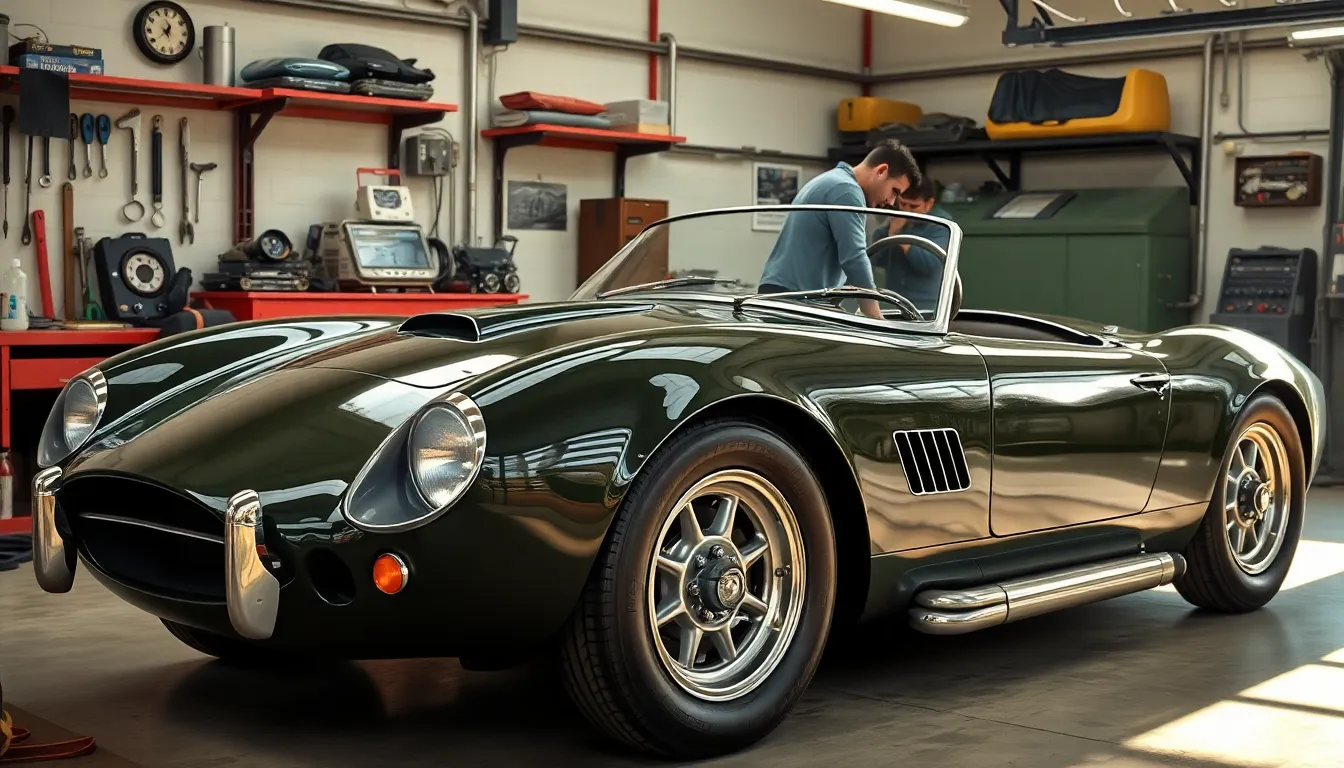
Preserving classic sports cars requires dedicated attention to specialized maintenance practices that differ significantly from modern vehicle care. Our investment in these automotive treasures demands meticulous upkeep to maintain their performance legacy and financial value.
Essential Maintenance Practices for Classic Sports Cars
Regular oil changes form the foundation of classic sports car maintenance, with most experts recommending intervals between 3,000 to 5,000 miles depending on driving conditions. Classic engines often require exact viscosity grades like 20W-50 or straight 30-weight oil that modern vehicles don’t use. Carburetor tuning becomes critical for pre-fuel injection models, requiring adjustment every 6-12 months to ensure proper air-fuel mixture ratios.
Ignition system maintenance involves replacing points and condensers in older distributor systems, typically every 12,000 miles or annually. We recommend checking spark plug gaps regularly since classic engines often require wider gaps than modern counterparts. Timing adjustments may need professional attention, as many classic sports cars use mechanical advance systems rather than computer-controlled timing.
Cooling system care demands special attention in classic sports cars due to older radiator designs and potential overheating issues. Flushing the cooling system annually prevents corrosion buildup that can damage vintage aluminum or brass components. Brake fluid replacement every two years becomes crucial since classic brake systems lack modern ABS technology and rely entirely on hydraulic pressure for stopping power.
Tire maintenance requires monitoring for dry rot and cracking, common issues when classic sports cars sit unused for extended periods. We suggest rotating tires every 5,000 miles and maintaining proper pressure since vintage suspension systems often lack modern stability features.
Finding Authentic Parts and Restoration Services
Specialized classic car parts suppliers offer original equipment manufacturer (OEM) components that maintain authenticity and value. Companies like Moss Motors, British Parts Northwest, and Classic Industries maintain extensive inventories for popular models like MG, Triumph, and Camaro. Online marketplaces such as Hemmings Parts and Pelican Parts provide searchable databases with part numbers and compatibility information.
Restoration services vary significantly in quality and specialization, making research essential before selecting a shop. We recommend visiting potential shops to examine current projects and speaking directly with previous customers about their experiences. Marque-exact specialists often provide superior knowledge for particular brands like Ferrari, Porsche, or Jaguar compared to general restoration shops.
Documentation becomes vital when sourcing parts and services, as authentic components command premium prices over reproduction alternatives. Original build sheets, service records, and parts receipts help verify authenticity during restoration projects. Reproduction parts manufacturers like NPD and Classic Performance Products offer high-quality alternatives when original components aren’t available or exceed budget constraints.
Professional networks through classic car clubs provide valuable referrals for both parts sources and skilled technicians. Local chapter meetings often feature vendor recommendations and member experiences with exact restoration services.
Storage and Preservation Best Practices
Climate-controlled storage protects classic sports cars from temperature fluctuations and humidity that cause rust formation and interior deterioration. Garage temperatures between 65-75°F with humidity levels below 50% create optimal conditions for long-term preservation. Concrete floors require vapor barriers or breathable car covers to prevent moisture wicking from the ground.
Fuel system preparation involves adding fuel stabilizers like STA-BIL or Star Tron to prevent ethanol-related damage during storage periods exceeding 30 days. We recommend filling gas tanks completely to minimize condensation formation, then running engines for 10-15 minutes to circulate treated fuel through the system.
Battery maintenance requires either removal for indoor storage or connection to battery tender systems that maintain proper charge levels without overcharging. Disconnecting negative battery cables prevents parasitic drain from vintage electrical systems that lack modern power management features.
Tire care during storage involves increasing air pressure by 5-10 PSI above normal operating levels to compensate for natural air loss over time. Moving vehicles monthly prevents flat spots from developing on tire contact patches, particularly important for high-performance tires on sports cars.
Ventilation systems help prevent musty odors and mold formation in stored classic sports cars, with small fans or moisture absorbers maintaining air circulation in enclosed spaces.
Conclusion
Classic sports cars represent more than just vehicles – they’re rolling pieces of history that connect us to automotive’s most exciting eras. Whether you’re drawn to the elegance of a Jaguar E-Type or the raw power of a Shelby Cobra these machines offer experiences that modern cars simply can’t replicate.
The journey into classic sports car ownership requires patience dedication and careful planning but the rewards extend far beyond financial returns. You’ll join a passionate community of enthusiasts who share your appreciation for craftsmanship and automotive heritage.
As values continue climbing and these treasures become increasingly rare now’s the time to take action. Start researching models that speak to your heart and budget – your perfect classic sports car adventure awaits.
Frequently Asked Questions
What makes a car qualify as a “classic sports car”?
A classic sports car must be at least 20-25 years old with limited production numbers, historical significance, and timeless design excellence. Key characteristics include superior performance capabilities, manual transmissions, minimalist interiors, and often open-top configurations. Racing heritage and successful competition backgrounds significantly enhance a car’s classic status.
Are classic sports cars good investments?
Yes, classic sports cars have become serious financial assets that often outperform traditional investments. Rare models like the Ferrari 250 GTO have appreciated dramatically over decades. Factors affecting value include rarity, provenance, condition, and racing heritage. However, buyers should budget for ongoing maintenance costs and market volatility.
Which classic sports cars are best for beginners?
First-time collectors should start with more accessible models like the MG MGB, early Ford Mustangs, or Porsche 914 to gain experience. These cars offer lower entry costs while still providing the classic sports car experience. Research price trends, budget for maintenance, and always get professional inspections before purchasing.
How do you properly maintain a classic sports car?
Classic sports cars require specialized care including regular oil changes with appropriate viscosity, carburetor tuning, ignition system maintenance, and cooling system care. Use authentic parts when possible, find quality restoration services, and maintain detailed documentation. Store in climate-controlled environments and prepare fuel systems for long-term storage.
What are the most valuable classic sports cars?
The most valuable classic sports cars include the Ferrari 250 GTO (worth millions), Shelby Cobra, Jaguar E-Type, Aston Martin DB5, Lamborghini Miura, and Porsche 911. British classics from the 1950s-60s, American muscle cars, Italian supercars, and German engineering masterpieces consistently appreciate in value.
How should classic sports cars be stored?
Store classic sports cars in climate-controlled environments to prevent rust and deterioration. Prepare the fuel system with stabilizers, maintain battery charge with tenders, keep tires properly inflated and rotate periodically, and use car covers for dust protection. Regular starts and short drives help maintain mechanical components.

